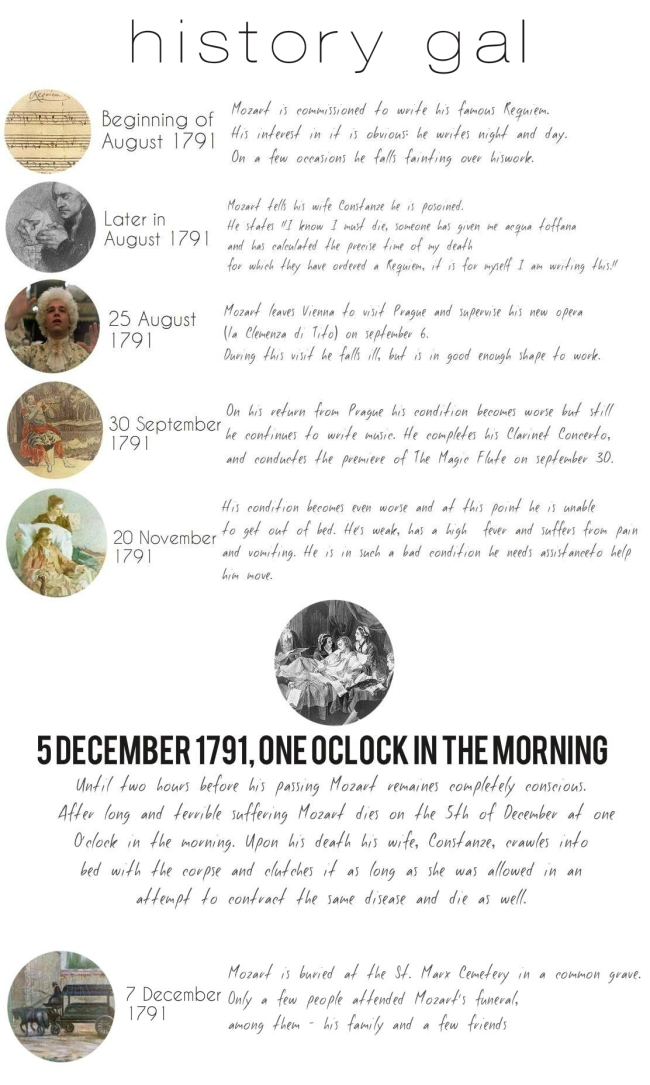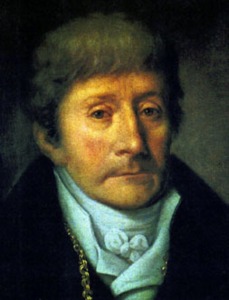“I thank my god for graciously granting me the opportunity of learning that death is the key which unlocks the door to our true happiness.”
Wolfgang Amadeus Mozart (27 January 1756 – 5 December 1791)
The genius composer Wolfgang Amadeus Mozart died on the fifth of December in his house in Vienna, Rauhensteingasse 8, following 15 miserable days of illness. On November 20th, during a fever epidemic, Mozart unexpectectly took ill – developing a high fever, headache, sweats and severe swelling and pain in his hands and legs. He was only 35 years old when he passed away. Below you can see a timeline I made of Mozart’s last weeks (short and brief):
Mozart’s sudden death quickly engendered rumors suggesting murdur, more specifically, poisoning. The cause of death was recorded as “severe miliary fever,” a vague description. Since his death, there have been countless theories as to what constituted severe miliary fever. An autopsy was never performed on Mozart.
The Medical Bag states the following:
“Without a corpse or autopsy report, all we have to go on today to determine the cause of Mozart’s death are eyewitness accounts of his symptoms and final hours. He unexpectedly took ill with a high fever, headaches, sweats, and dramatic swelling and pain in his hands and legs. By the 14th day, his swelling had increased to the extent that his entire body took on blimp-like proportions. Accompanying the swelling were nausea, vomiting, diarrhea, muscle pain, a rash, and an overpowering stench. He was extremely irritable to the point where he banished his beloved pet canary from his bedroom. Just 15 days after the onset of his illness, Mozart went into convulsions, lapsed into a coma, and died.
His 7-year-old son, Karl, noted that a few days before Mozart died his entire body became so swollen that the smallest movement was almost impossible. He also noted that there was an awful stench, which after death made an autopsy impossible. It was also observed that upon death the corpse did not become stiff and limbs were able to be bent, which is often the case when someone is poisoned. “
The death of Mozart is still food for speculations and theories, with for example the Daily Mail posting an article in 2011, claiming Mozart died because of lack of sunlight. (See it here: http://www.dailymail.co.uk/news/article-2015305/Mozart-died-35-didnt-sun.html)
Two years before that, in 2009, Bloomberg posted an article claiming Mozart died of strep throat (See it here: http://www.bloomberg.com/apps/news?pid=newsarchive&sid=aNPHGekzv2SU).
According to Dr. William J. Dawson, one investigator counted 118 different theories regarding the composer’s death that have been posited over the centuries. Dr. Dawson grouped the theories into four main categories: infection, renal disease with associated complications, poisoning, and cardiac disease.
Dr. Dawson believes that Mozart’s death was almost certainly hastened by the very treatment meant to restore his health: bloodletting.
“Mozart had a 2-week history of what sounds like a very febrile, painful illness that caused his joints to swell,” said Dr. Dawson. “But personally, I think acute hemorrhagic shock from being bled was the proximate cause of death.”
The composer may have lost as much as 2 liters of blood per week.
The poisoning theory.
In his last years, Antonio Salieri (rivaling composer), suffered from sinelity and and allegedly claimed that he had poisoned Mozart. This tale reached others, including Beethoven. Constanze, fanned the rumour’s flame by endorsing it; she also believed that Salieri had plotted against her husband. This rumour was denied by many of Mozart’s closest associates including his personal physician who reported that Wolfgang had died of the fever.
In fact, Salieri and Mozart actually respected each other as musicians during Mozart’s lifetime. Salieri recognized Mozart’s gifts as a musician and envied them, while Mozart envied Salieri for how he found so much favor with the authorities (the monarchy).
The following clip from the 1997 movie Amadeus shows the death of Mozart, but in contrast to reality Mozart is buried and sewed into a linen sack. General practice was to place up to 4 to 5 adults and 2 children in a common pit. The practice gave rise to the notion that Mozart died a pauper in obscurity, which was not the case.
For books and more click picture below:
Here’s a wonderful video from Haley Rempel giving a Two-Minute Talk about the Death of Mozart.
Source:
http://www.aaos.org/news/aaosnow/nov10/youraaos2.asp
http://www.youtube.com/watch?v=euNrfHRjPQA
http://snow.sierranevada.edu/~csci/WhatKilledMozart.htm
http://www.themedicalbag.com/story/wolfgang-amadeus-mozart
http://www.piano-play-it.com/how-did-mozart-die.html
http://www.luxurytraveler.com/mozart_vienna.html
http://h2g2.com/approved_entry/A1304957
http://www.chron.com/news/bizarre/article/Cause-of-Mozart-s-death-revealed-218-years-1735278.php
http://en.wikipedia.org/wiki/Death_of_Wolfgang_Amadeus_Mozart
http://www.bloomberg.com/apps/news?pid=newsarchive&sid=aNPHGekzv2SU




